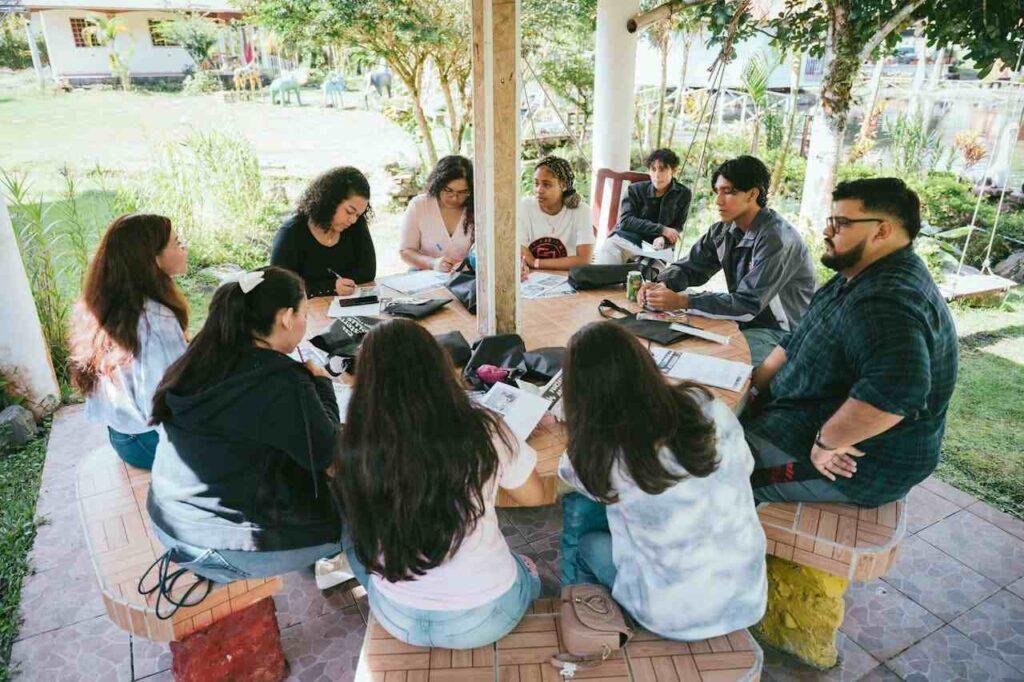Regarding the IB TOK presentation, I know how hard it can be to create something that meets the IB requirements and keeps people interested. These presentations are an essential part of the course because they give students a way to organize their thoughts about difficult knowledge questions. In my experience, knowing how to make your case simply and convincingly is the most important thing.
What Is a TOK Presentation?
Regarding the IB curriculum assignments, the TOK presentation ranks high among the most difficult. The assignment asks students to reflect on knowledge acquisition and application by relating a real-life scenario to a knowledge question.
The unique selling point is the harmony it achieves between abstract ideas and real-world applications. As per the overall IB criteria, students are expected to demonstrate how varied viewpoints enrich our knowledge of the world by developing their arguments using Areas of Knowledge and Ways of Knowing.
However, here’s a warning: the TOK syllabus is changing! If you’re taking IB exams in 2022 or later, the TOK presentation will be replaced by the TOK exhibition, a different internal assessment. The TOK exhibition focuses more on how TOK concepts apply to everyday life, slightly different from the presentation’s focus on abstract knowledge questions.
That said, if you’re preparing for the TOK presentations, keep in mind the following essentials:
- Real-life situation. Start with a relevant and thought-provoking real-life scenario.
- Knowledge question. Ensure your question reflects how knowledge is obtained or used.
- AOKs and WOKs. Use these to structure and develop your argument.
The essay component of TOK lets you go into more detail with your analysis, while the presentation part focuses on transparency, communication, and using TOK ideas in real life. From my observation, the best TOK presentations break complex ideas into simple, understandable language while still sticking to a solid academic base.
You must be clear and to the point so that people can see how your question applies to real life. Also, explaining these ideas is as important as having the correct information. That’s what makes the IB TOK presentation different from other tests in the IB program: this mix of skills.
What Are the Best TOK Presentation Examples?
To help you understand what a successful TOK presentation looks like, I’ve put together a couple of examples based on real-life situations I’ve used in my work.
1. The Ethics of Artificial Intelligence
Real-life Situation: The rise of AI-powered face recognition in the police force. Police increasingly use AI to identify suspects, which has led to discussions about privacy, ethics, and accuracy.
Knowledge Question: “To what extent should ethical considerations limit technological advancements in AI?”
AOKs & WOKs: As the central Area of Knowledge, I looked into ethics. I focused on reason and emotion as Ways of Knowing. Ethical theories like utilitarianism and deontology were also central to the presentation.
The pros and cons of increased safety were weighed against the possibility of violating human rights. For example, I asked myself if giving up privacy for more protection was okay. I showed how different ethical views on AI use can be seen through case studies from China and the U.S.
Explanation: The hardest part was finding a balance between the draw of technical growth and the moral worries about personal freedom. It helped me conclude that I learned more about both sides of an ethical argument. This example of a TOK presentation stresses how important it is to consider the moral effects of new technology when making it.
2. Memory and Historical Narratives
Real-life Situation: Different countries have different versions of the history of World War II. For example, how Japan and China teach about the same past events in their textbooks shows how their respective countries remember those events.
Knowledge Question: “How does memory influence how history is recorded and understood?”
AOKs & WOKs: I used history as my AOK and memory and how we understand the world around us as my WOKs to look into how different groups remember and understand the same events in various ways.
The presentation was mostly about how cultural background shapes group memory and how that memory affects history stories. I looked at how different countries remember the past, showing biases strengthened by selective memory.
Explanation: I believe that memories significantly impact events. When I put together a TOK presentation on these topics, I think it’s important to remember that our memories aren’t just a way to store information; our personal and national views also shape them.
This TOK presentation example helped show that past information is never neutral and can be interpreted differently.

3. Social Media and the Concept of Truth
Real-life Situation: There is false information and “fake news” on social media sites, especially around election times and significant global events.
Knowledge Question: “To what extent does social media shape our perception of truth?”
AOKs & WOKs: In this presentation, I used reason and language as WOKs to examine media studies. I talked about how algorithms and user-generated material can change how people see the truth.
I also examined how language is used to change people’s minds. Comparing cases of false headlines to articles based on facts showed the thin line between what people think and what is true in the digital age.
Explanation: Because social media affects our daily lives, this topic hits home with today’s kids. Giving fair reasons is hard because you have to see both the good and bad sides of social media and how it can be used to spread false information.
The main point of this TOK presentation example was to show how to think critically about digital material.
4. The Role of Intuition in Scientific Findings
Real-life Situation: Many critical scientific findings, like Einstein’s theory of relativity, are said to have come about through gut rather than rational reasoning.
Knowledge Question: “To what extent does intuition play a role in scientific knowledge?”
AOKs & WOKs: I chose natural sciences as my AOK, and perception and reason were my WOKs. I examined how intuition plays a part in scientific findings by reviewing past cases, such as Einstein’s “thought experiments” and Kekulé’s finding of the benzene ring. The presentation stressed that science is usually linked to logic, but intuition can often lead researchers to new findings.
Explanation: I think it’s interesting for students to learn about the surprising ways that gut helps science move forward.
While science is all about strict reasoning, this TOK presentation example shows that feeling can still be helpful in the search for knowledge.
5. Cultural Relativism and Moral Judgments
Real-life Situation: There is a debate about using cultural rites, such as animal sacrifice, in particular religious traditions and how various civilizations perceive them.
Knowledge Question: “To what extent does cultural context influence moral judgments?”
AOKs & WOKs: For this TOK presentation example, I chose ethics as an AOK and emotion and reason as WOKs.
I investigated how various cultures explain their moral ideas and how they may contradict universal ethical norms. Through real-world examples, such as animal rights conflicts, I demonstrated how emotion forms moral beliefs and how reason seeks to defend them.
Explanation: This topic makes students think about how moral decisions are relative and forces them to consider how they can balance different ethical points of view. This TOK presentation helps people understand how hard it is to make moral decisions in a world with many other cultures.
6. The Role of Language in Shaping Political Power
Real-life Situation: Political talks and news stories can change people’s minds during elections or national disasters.
Knowledge Question: “How does the use of language shape political power and authority?”
AOKs & WOKs: I investigated the AOK of human sciences, especially political science, and used language and reason as WOKs. By examining famous political talks and news stories about them, I showed how words can be used to control, convince, and strengthen power.
The presentation looked at examples from current media sources and leaders like Winston Churchill.
Explanation: This TOK presentation shows how deeply language affects our understanding of power. Students can better understand how communication and power work together by thinking critically about political rhetoric.

Need Help with Your IB TOK Presentation?
From research and analysis to structuring and editing, our skilled mentors will be by your side, helping you create an exceptional TOK presentation that meets the word count and stringent IB criteria.
7. The Influence of Technology on Human Interaction
Real-life Situation: The increasing use of smartphones and social media has transformed how people interact, often reducing face-to-face communication.
Knowledge Question: “To what extent has technology altered human interaction and communication?”
AOKs & WOKs: I picked the human sciences, focusing on psychology and sociology as AOKs and language and sense perception as WOKs. I discussed how technology changes our ideas about connection, emotional engagement, and communication rules by examining studies that examine how social media affects relationships.
Explanation: This topic is relevant to students today because it discusses a significant change in how we interact. It’s crucial to find the right balance between technology and real human contact.
So, this TOK presentation example shows how important it is to keep real ties even as technology improves.
Final Thoughts
A good TOK presentation needs a clear framework, perfect delivery, and a focus on the knowledge question. Using real-life examples and proper use of AOKs and WOKs can help you make a presentation that meets IB standards and sticks with your audience. I think practice is the key to success. Work on how you say things, make your points, and always be ready for comments.
In conclusion, I hope that my tips and TOK presentations examples help you as you prepare your project. If you know how to do it right, you can share your thoughts with confidence and success. So, good luck, and feel free to contact our TOK and EE writers if you need help.
Luke MacQuoid
Luke MacQuoid has extensive experience teaching English as a foreign language in Japan, having worked with students of all ages for over 12 years. Currently, he is teaching at the tertiary level. Luke holds a BA from the University of Sussex and an MA in TESOL from Lancaster University, both located in England. As well to his work as an IB Examiner and Master Tutor, Luke also enjoys sharing his experiences and insights with others through writing articles for various websites, including extendedessaywriters.com blog
- 100+ Famous Quotes on Languageby Luke MacQuoid
- 100+ Famous Quotes on Indigenous Societiesby Luke MacQuoid
- 100+ Famous Quotes on Religionby Luke MacQuoid
- November 2025 TOK Essay Prompts – Explained!by Luke MacQuoid
- TOK Optional Themes – Knowledge & Technologyby Luke MacQuoid
- TOK Optional Themes – Knowledge & Politicsby Luke MacQuoid





